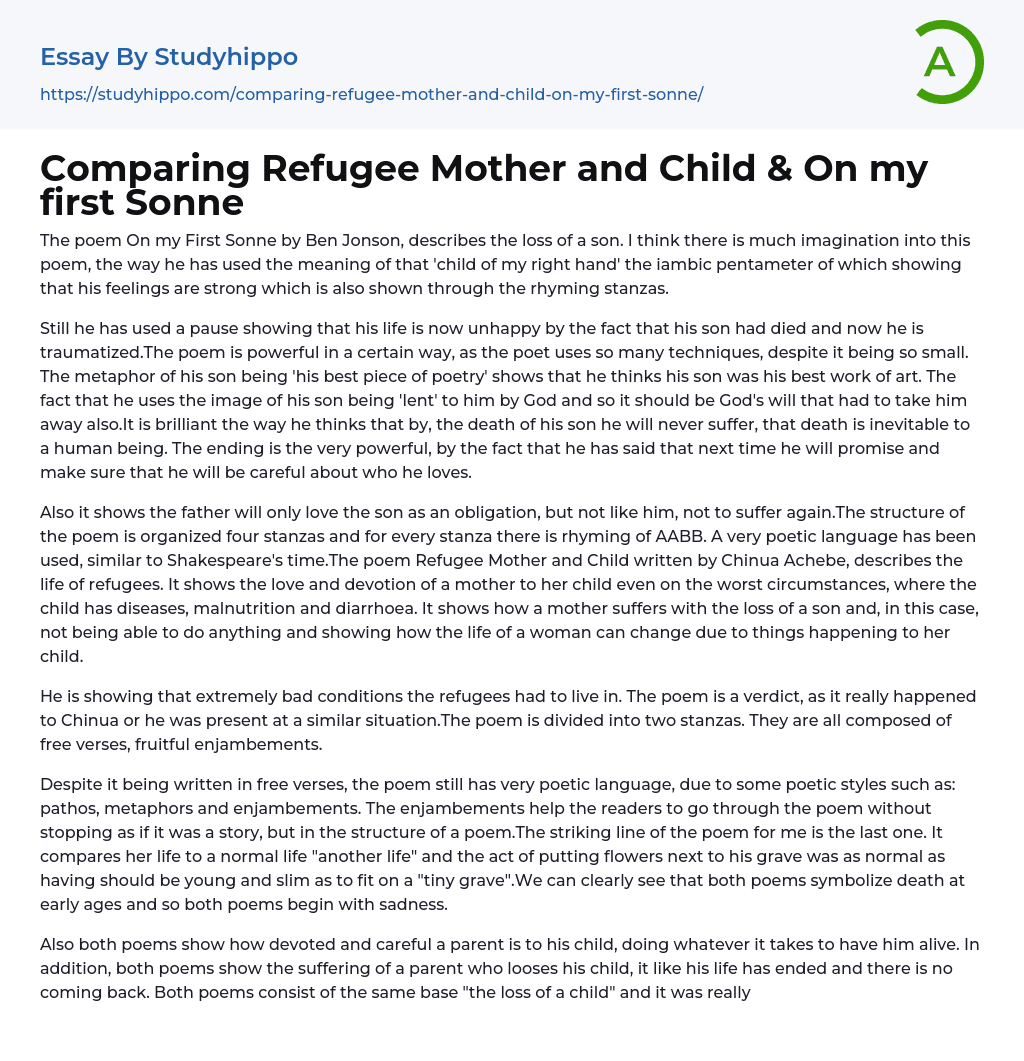

Comparing Refugee Mother and Child & On my first Sonne Essay Example
Ben Jonson expresses his intense grief for the loss of his son in a creative manner within his poem "On my First Sonne." By utilizing iambic pentameter and referring to his child as "child of my right hand," Jonson effectively conveys the depth of his emotions. Additionally, the rhyming stanzas serve to accentuate this sentiment even further.
Despite its brevity, the poem employs numerous techniques to convey the speaker's profound grief over the loss of his son. He utilizes a pause to emphasize his present unhappiness, traumatized by the death of his child. The metaphor of his son as "his best piece of poetry" conveys the idea that his child was his greatest artistic achievement. Furthermore, the speaker suggests that God "lent" him his son and it was God's will to take him back, accepting death as an inevitable part of human
...life. The poem ends powerfully with the speaker vowing to be careful about whom he loves in the future.
Chinua Achebe's poem, "Refugee Mother and Child," depicts the struggles of refugees and portrays a mother's unyielding love for her child despite dire circumstances such as diseases, malnutrition, and diarrhea. Achebe employs poetic language reminiscent of Shakespearean times and structures the piece into four rhyming stanzas with AABB rhyme scheme. The poem also highlights the devastation a mother experiences with the loss of her child and illustrates the impact it has on a woman's life when events beyond her control affect her child.
The poem depicts the harsh living conditions of refugees and is a firsthand account by Chinua or at least based on a similar situation. Divided into two stanzas, the poem consists entirely
of free verses with effective enjambments.
Despite its free verse form, the poem incorporates a range of poetic devices, including metaphors, pathos, and enjambments to enrich its language. Enjambments help maintain the structural integrity of the poem while ensuring a seamless flow for readers. The final line is particularly impactful as it likens the narrator's life to an ordinary one and highlights how placing flowers on a grave becomes commonplace over time. This is similar to being "young and slim" enough to fit into a "tiny grave." Both poems deal with death at young ages and have somber beginnings.
Both poems centered around the theme of a parent's unyielding love for their child, willing to do whatever it takes to keep them alive. The works also emphasized the profound sorrow felt by a parent when they lose their child, as if their own life has ended. The main topic of both pieces was the death of a child, depicted with great expertise. The only difference between them was in how the child died.
- Book Summary essays
- Metaphor essays
- Reader essays
- Rhyme essays
- Literary devices essays
- Villain essays
- Books essays
- Genre essays
- Literary Criticism essays
- Writer essays
- Protagonist essays
- Simile essays
- Poem essays
- Book Report essays
- Book Review essays
- Greek Mythology essays
- Plot essays
- Tragic Hero essays
- Coming of Age essays
- Play essays
- Rhetoric essays
- Rhetorical Question essays
- Translation essays
- Understanding essays
- Reason essays
- Character essays
- Letter essays
- American Literature essays
- Literature Review essays
- Utopia essays
- Poetry Analysis essays
- Dante's Inferno essays
- Between The World and Me essays
- Incidents in The Life of a Slave Girl essays
- Flowers for Algernon essays
- Myth essays
- Everyday Use essays
- Boo Radley essays
- Genesis essays
- Richard iii essays
- Alice in Wonderland essays
- On the road essays
- Ozymandias essays
- The Nightingale essays
- Holden Caulfield essays
- Animal Farm essays
- 1984 essays
- A Hanging essays
- Shooting An Elephant essays
- A Tale Of Two Cities essays



